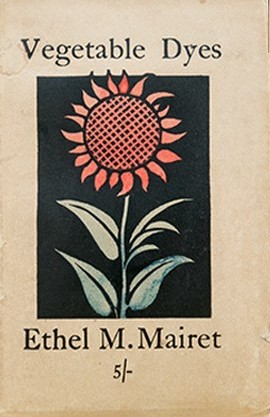Dear Readers:
Welcome to the Spring 2017 Edition of the Turkey Red Journal. Warmer weather has finally arrived in the Chicago area and I was able to spend the Memorial Day holiday weekend transplanting dye plants. My friend and horticulturalist, Tom Martin, started some of my seeds in his greenhouse. The cota (Thelesperma filifolium), Mexican marigold (Tagetes lucida) and the Japanese Indigo (Polygonum tictorium) were all strong and healthy, just waiting for the right temperature for planting.
This year, I'm participating in a group research project with John Marshall and a number of other dyers around the United States. We are all growing Japanese Indigo (using seeds provided by John) and will be documenting our growing and dye processes. If you are interested, you can follow our progress by going to http://johnmarshall.to/TSG/TadeaiStudyGroup.htm. We are hoping to publish the results of the experiments in the TRJ Spring 2018 edition.
My new experimental dye plant this year is Mexican marigold. I'm interested to see how it grows in this region (Zone 5a) and how they compare to the French marigold (Tagetes patula) traditionally used in our gardens. Last year, I planted Rabbitbrush (Chrysothamnus nauseosus) seeds supplied by Glenna Dean from Arizona; three of the plants survived the Chicago winter. I hope they mature enough this season to use for dyeing.
In this edition of the Turkey Red Journal, Caroline Harper, owner of Chi design Studio, describes her passion to revive indigo production in South Carolina in the article "Indigo Renaissance." Her studio grows and processes indigo, along with creating usable wearable art and also offers classes in the indigo process.
In her article, "Dyeing with Ethel Mairet in Navasota, Texas," Virginia Hamilton describes a collaborative dye project to celebrate the 100th anniversary of the publishing of Ethel Mairet's book, A Book on Vegetable Dyes. The project originated with the Dichtling Museum of Art and Craft in East Sussex, England. Her article includes links to photographic copy and e-book version of the original book.
Helen Melvin's article, "A Felted Journey with Botanical Colours," describes the processes she uses to make her Welsh countryside-inspired felted landscapes. It is interesting to read about her 25-year journey in learning about natural dyes and the many mentors she credits for her knowledge. Melvin has self-published four books on natural dyes and has her own line of natural pigment inks.
We have moved to an open submission policy for articles, artwork, exhibit notices and reviews for for upcoming issues. We are interested in featuring dyers from around the world, so don't hesitate to submit your ideas for articles. Send your submissions to madder@comcast.net.
Back issues of the print version of the TRJ are still available for purchase. Contact me directly for further information. Please keep sending in your thoughts and suggestions. We appreciate all your comments.
If you are not currently on the TRJ new issue notification mailing list and would like to receive notification when the new issue is online, please send an email to madder@comcast.net. Your email address will not be shared with others.
As always, a special thanks to Bob Feldman, our copy editor and webmaster for all his hard work. I would like to extend a warm welcome to Virginia Hamilton who volunteered to help with the copy editing. Thanks so much Virginia.
Pamela FeldmanEditor and Publisher
www.pamelafeldman.com
 Turkey Red Journal
Turkey Red Journal
